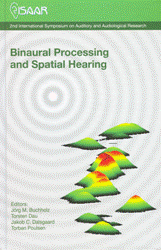Natural directionality II: next generation asymmetric fitting
Resumé
Hearing in noise is the largest problem reported by hearing-impaired people and the problem often persists after hearing aid fitting. Hearing aid directionality is used to increase the signal-to-noise ratio, but also introduce problems as inaudibility. To address this audibility issue GN ReSound introduced asymmetric fittings. The solution, however, contained problems related to directional microphone technology, such as noise introduced as a result of the equalizing for inherent low-frequency roll-off. To solve these issues the strategy for asymmetric ttings was further developed, resulting in the next generation of asymmetric fitting. This article will review the background for asymmetric ttings. Results from earlier studies will be summarized and issues that have been identi ed with GN ReSound’s launch of rst generation of asymmetric tting, Natural Directionality, will be discussed. Further research has been carried out addressing those identi ed issues and the solutions will be presented. Clinical data will back up improvements in GN ReSound’s next generation of asymmetric fitting, Natural Directionality II.
Referencer
Bentler, R. A., Egge, J. L. M, Tubbs, J. L., Dittberner, A. B., and Flamme, G. A. (2004). “Quanti cation of directional bene t across different polar response patterns,” J Am Acad Audiol 15, 649-659.
Bregman, A. S. (1990). Auditory Scene Analysis: The Perceptual Organization of Sound (MIT Press).
Cord, M. T., Surr, R. K., Walden, B. E., and Dyrlund, O. (2004). “Relationship between laboratory measures of directional advantage and everyday success with directional microphone hearing aids,” J Am Acad Audiol 15, 353-64.
Cord, M. T., Walden, B. E., Surr, R. K., and Dittberner, A. B. (2007). “Field evaluation of an asymmetric directional microphone tting,” J Am Acad Audiol 18, 245- 256.
Hawkins, D. B. and Yacullo, W. S. (1984). “Signal-to-noise ratio advantage of binaural hearing aids and directional microphones under different levels of reverberation,” J Speech Hear Disord 49, 278-286.
MacKenzie, E., and Lutman, M. E. (2005). “Speech recognition and comfort using hearing instruments with adaptive directional characteristics in asymmetric listening conditions,” Ear Hear 26, 669-79.
Madison, T., and Hawkins, D. (1983). “The signal-to-noise ratio advantage of directional microphones,” Hearing instruments 34, 18,49.
Nielsen, H. B. (1973). “A comparison between hearing aids with directional microphone and hearing aids with conventional microphone,” Scand Audiol 2, 45-48.
Pumford, J., Seewald, R., Scollie, S., and Jenstad, L. (2000). “Speech recognition with in-the-ear and behind-the-ear dual microphone hearing instruments,” J Am Acad Audiol 11, 23-35.
Ricketts, T., and Hornsby, W. (2003). “Distance and reverberation effects on directional bene t,” Ear Hear 24, 472-484.
Valente, M., Fabry, D., and Potts, L. (1995). “Recognition of speech in noise with hearing aids using dual microphones,” J Am Acad Audiol 6, 440-449.
Wagener, K., Jovassen, J. L., and Ardenkjær, R. (2003). “Design, optimization, and evaluation of a Danish sentence test in noise” Int J Audiol 42, 10-17.
Walden, B. E., Surr, R. K., Cord, M. T., Dyrlund, O. (2004). “Predicting hearing aid microphone preference in everyday listening,” J Am Acad 15, 365-96.
Walden, B. E., Surr, R. K., Cord, M. T., Edwards, B. E., and Olson, L. (2000). “Comparison of bene ts provided by different hearing aid technologies,” J Am Acad Audiol 11, 540-560.
Wouters, J., Litiere, L., and Wieringen, A van. (1999). “Speech intelligibility in noisy environments with one- and two-microphone hearing aids,” Audiology 38, 91-98.
Yderligere filer
Publiceret
Citation/Eksport
Nummer
Sektion
Licens
Authors who publish with this journal agree to the following terms:
a. Authors retain copyright* and grant the journal right of first publication with the work simultaneously licensed under a Creative Commons Attribution License that allows others to share the work with an acknowledgement of the work's authorship and initial publication in this journal.
b. Authors are able to enter into separate, additional contractual arrangements for the non-exclusive distribution of the journal's published version of the work (e.g., post it to an institutional repository or publish it in a book), with an acknowledgement of its initial publication in this journal.
c. Authors are permitted and encouraged to post their work online (e.g., in institutional repositories or on their website) prior to and during the submission process, as it can lead to productive exchanges, as well as earlier and greater citation of published work (See The Effect of Open Access).
*From the 2017 issue onward. The Danavox Jubilee Foundation owns the copyright of all articles published in the 1969-2015 issues. However, authors are still allowed to share the work with an acknowledgement of the work's authorship and initial publication in this journal.


